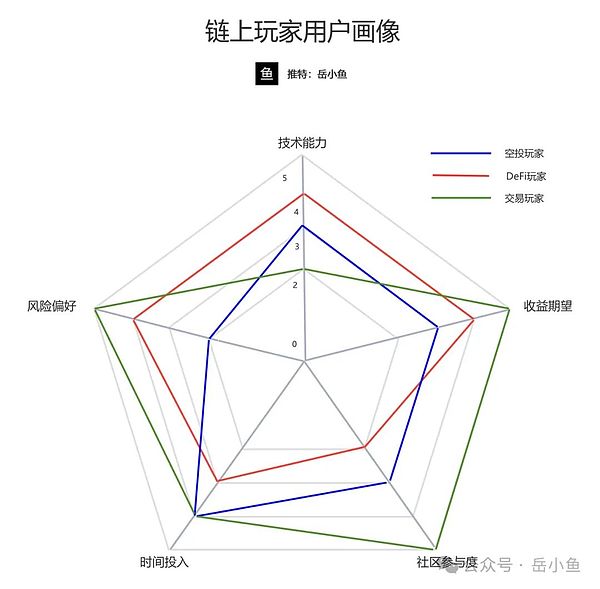Author: Yue Xiaoyu
On-chain users can be roughly divided into three categories: airdrop players, DeFi players, and trading players.
Airdrop players:These players focus on participating in the airdrop activities of Web3 projects and obtain token rewards at low or even zero cost. Their goal is usually to make short-term profits, and they are often called "毛毛党".
DeFi players:These users are keen on DeFi, earning income by providing liquidity, staking, lending, arbitrage, etc., and pursuing more stable long-term returns.
Trading players:Actually, this refers specifically to meme coin players, who are mainly speculative and expect to catch the golden dog and get rich.
These three user groups have very significant characteristics. I use radar charts to make a comprehensive comparison. You can see which type of player you belong to and which type of player you want to be.
The overall comparison is divided into 5 dimensions: technical ability, risk preference, time investment, community participation and profit expectations.
The score range is 1-5 (1 is the lowest, 5 is the highest).

First, the conclusion:
Airdrop players: The radar chart presents a shape that tends to be "time investment", with medium technical capabilities and community participation, low risk appetite and return expectations, forming a relatively balanced but inner-biased pentagon.
DeFi players: The radar chart highlights "technical ability" and "risk preference", with high return expectations, but low community participation and time investment, forming a graph that expands outward but has a narrow bottom.
Meme coin trading players: The radar chart strongly favors "risk preference", "return expectations", and "community participation", with low technical ability, forming an overall outward graph.
You can consider combining it with your behavioral preferences:
If you are a person with plenty of time, no capital and low risk appetite, then you are suitable to be an airdrop player;
If you are a technology-driven person who likes research and has a certain amount of funds, then you can become a DeFi player;
If you are a person who likes speculation, can bear high risks and expects to get rich through trading, then you can consider becoming a meme coin player.
The following is a specific analysis:
1. Airdrop players
Technical ability (3/5): You need to master basic blockchain operations (such as wallet usage, interactive test network), but you don’t need to have an in-depth understanding of smart contracts or complex DeFi mechanisms.
Risk preference (2/5): The risk is relatively low, because the investment cost is usually only time and a small amount of gas fee, and there is no big loss if you fail.
Time investment (4/5): A lot of time is needed to research new projects and complete tasks (such as Discord activities, test interactions) to ensure that airdrop opportunities are not missed.
Community participation (3/5): Active on platforms such as Discord and Twitter, but more for completing tasks rather than deeply participating in community culture.
Expected returns (3/5): Expect to get considerable returns through airdrops, but due to the uneven quality of projects, the uncertainty of returns is high.
2. DeFi players
Technical ability (4/5): Need to understand complex DeFi protocols (such as Uniswap, Aave), fund pool mechanisms and risk management (such as impermanent loss).
Risk preference (4/5): Willing to take higher risks (such as smart contract vulnerabilities, market volatility), but usually reduce losses by diversifying investments.
Time investment (3/5): Need to monitor the market and adjust strategies regularly, but not as frequently as airdrop players.
Community participation (2/5): More concerned with personal gains rather than community activities, relatively low participation, unless it involves governance voting.
Income expectations (4/5): Seeking a stable and high annualized rate of return (such as 10%-100%), not very interested in short-term wealth.
3. Trading players
Technical capabilities (2/5): Simple operation, only basic wallet and trading knowledge are required, no in-depth technical understanding is required.
Risk Preference (5/5): Extremely high risk tolerance, willing to participate in projects with a high probability of "zeroing out", and pursue the dream of "hundred-fold coins".
Time Investment (4/5): Mainly dependent on market sentiment and hot spots, so it is necessary to sit and scan the chain, always pay attention to community dynamics, and the time investment is also very large.
Community Participation (5/5): Highly active in the Meme coin community (such as Twitter, Telegram), driving up prices through hype and dissemination.
Expected return (5/5): Expecting super high returns (such as 100 times or even 1,000 times), but the success rate is extremely low, more of a gambling mentality.
To sum up
No matter what type of player, there is no best, only the most suitable for yourself, so you have to find the track that suits you best.
For me, my learning path is:
From the very beginning of the airdrop player, I can also earn income in the process of experiencing the product learning project;
To the later DeFi players, I further understood the protocol and on-chain operations, and mined everywhere to earn income;
To today's on-chain trading players, catching up with popular narratives, and looking for the code to wealth on the chain.
My identity and positioning have changed many times, but what remains unchanged is that I have been constantly learning new things, constantly breaking through my limitations, and trying to keep up with the rapid development of the industry.
Find the track that suits you, and then just move forward!
 Catherine
Catherine





